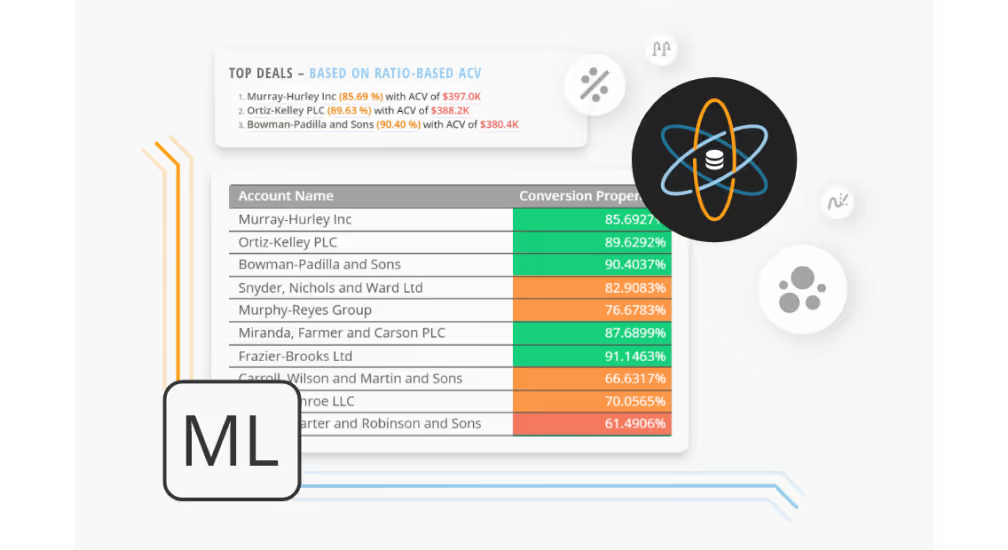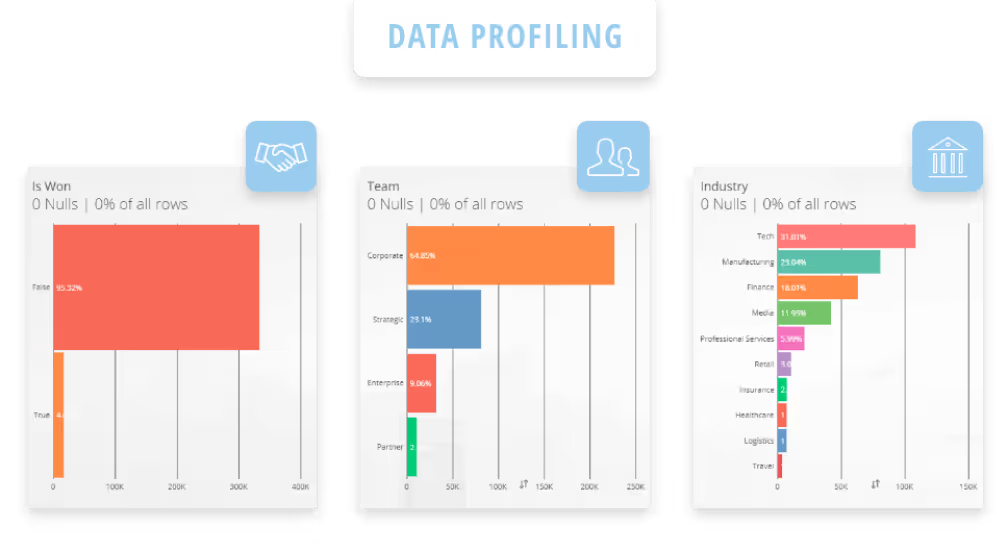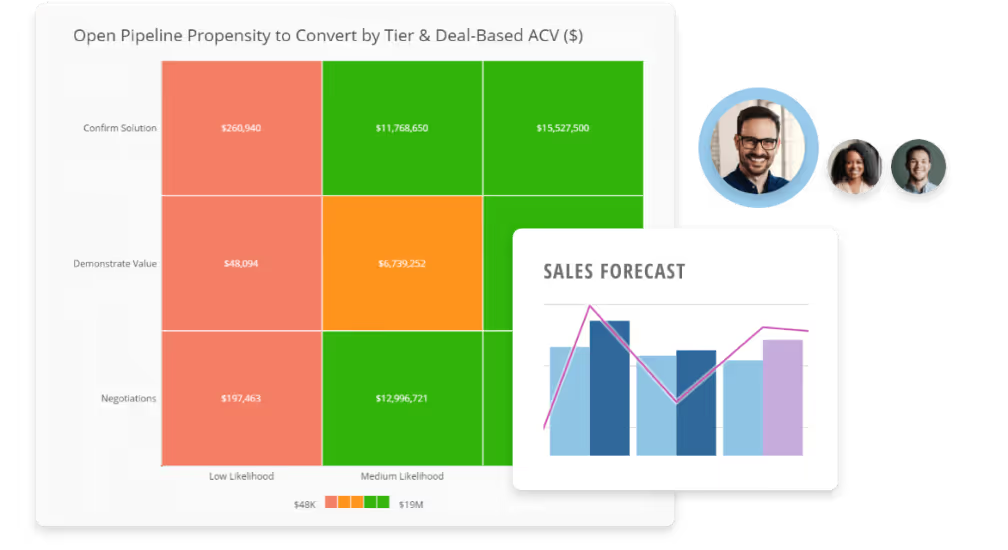
Saved 100s of hours of manual processes when predicting game viewership when using Domo’s automated dataflow engine.

At this point, business intelligence isn’t at the cutting edge of business data strategies. It’s an established and respected part of the data industry. BI solutions aren’t rare tools that only the most data-driven businesses use; they’re the basic building blocks that every business needs to survive.
Nowadays, data-driven businesses are looking at new technologies that can leverage the power of BI. Business intelligence isn’t the future—it’s the present. The future is BI-based machine learning; using a BI tool to provide completely automated insight.
Businesses can use machine learning to accomplish things that would be impossible, or at least extremely time-consuming, with regular BI tools. The largest enterprises have already started to leverage machine learning, and it’s time for the average business to follow suit.
Modern, market-leading BI tools can help a business harness the power of machine learning. However, before a business jumps in head-first, they need to know what machine learning is and what it can do for them.

Machine learning refers to a broad category of analytical techniques that use algorithms and other learning tools to iterate on successes. That’s a somewhat vague definition, and it’s a lot easier to understand with an example.
Say you want to build an email filter for your business. You want to make sure ‘good’ emails get through while ‘bad’ emails are blocked. To do this, you either have to filter emails manually (which defeats the purpose of building a filter) or use simple word or sender filtering.
Either way, the filter is going to be imperfect. Good emails will get blocked, bad emails will get through, and having the filter can even end up more frustrating than having no filter in the first place.
Machine learning can help solve this problem. If you’ve been trying to filter your emails for a while, you’ll have big collections of ‘good’ and ‘bad’ emails. A machine learning algorithm can find commonalities and figure out what makes a good email good and a bad email bad.
From there, the algorithm can filter out emails that have ‘bad’ characteristics and let through ‘good’ ones. This is similar to filtering the emails manually—it’s evaluating each email and using its own best judgment to classify it—but it’s all completely automated.
Initially, the algorithm might not be very good at making those judgements. But by providing feedback, you can sharpen the algorithm’s decision-making. If it’s marking a lot of bad emails as good, you can flag those choices as incorrect, and the algorithm can learn from its mistakes.
Over time, this process of making mistakes and getting feedback makes the algorithm better and better at making those choices. Eventually, it’ll make very few mistakes and work better and faster than a human in the same role.
This simple loop, where an algorithm is trained on an initial data set, makes decisions based on past experience, and then learns from its mistakes, is the core of any machine learning use case.
While it may seem simple, machine learning has all sorts of use cases. Any business in any industry can find places where machine learning can streamline their operations, solve persistent problems, and find new insights.
Businesses don’t need to invest in expensive machine learning tools to access machine learning benefits. Many BI tools offer machine learning capabilities that can help businesses build algorithms and find insight.
Machine learning can be very complicated, and if a business had to work on their algorithms from scratch, it’d be very difficult. Luckily, there are already established use cases for machine learning that businesses can use to jumpstart their machine learning success.
These use cases meet needs that are very common among businesses and allow companies to get analytics that would be impossible otherwise. Just because these use cases are somewhat simple doesn’t mean they aren’t effective.

Some of these use cases are:
Many businesses already access predictive analytics as part of their basic BI strategy. While these basic predictive capabilities can be useful, machine learning can provide even deeper insight.
Predictive analytics uses a business’s historical and current data to provide insight into how things will trend in the future. They’re used for techniques like forecasting, which predicts future data, and what-if scenarios, where users can see how a change in one metric could affect other ones.
If a business’s predictive analytics aren’t powered by machine learning, the sorts of insights that they’ll get will be limited. Their business forecasts might be derived from simple best-fit lines, for example.
For real predictive power, businesses need to leverage machine learning. Machine learning can delve much deeper into the relationships between data points, which allows for much more accurate predictive models than best-fit lines.
Once a business has used machine learning to build predictive models, those models become more effective every time their predictions are proved to be correct or incorrect. A success is obviously best, but a machine learning algorithm learns even more from a failure.
Over time, these models begin to accurately predict future trends, and they allow businesses to prepare for the future with near certainty.
Often, businesses want to analyze data that’s not in a helpful numerical format. This might be text data, images, or other data formats that can’t be easily expressed numerically.
In those cases, businesses need to find some way to transfer the implications of their non-numerical data into a numerical format so that they can analyze it in conjunction with other streams of data.
In the past, this could be a long and time-consuming process. Someone might have to manually parse all the qualitative data and then present it in a way that others can understand.
Machine learning can streamline this process and allow businesses to really put their qualitative data to work. With simple processes, it can analyze non-numerical data and produce implications that can be used for insight.
One of the most popular machine learning techniques for this situation is called ‘sentiment analysis.’ It allows businesses to glean the overall opinion of a body of text. This approach is particularly useful for things like customer feedback, reviews, and other measures of marketing success.
In sentiment analysis, a machine learning algorithm parses a piece of text and then picks out words that express an opinion. From there, it decides whether those words express a positive or negative opinion. For example, it might pick out the words ‘awesome,’ ‘terrific,’ and ‘good,’ and decide that the text has a positive opinion.
This can allow businesses to effectively gauge customer opinion based on things like reviews or customer feedback. From there, they can do further analysis on the reviews to find commonalities between them and figure out what people’s specific complaints are.

Algorithms can help to automate all sorts of processes that otherwise would need manual input. In any sort of situation where human judgment is important, an algorithm can meet that same need without any explicit human input.
For example, a sales team might score their leads based on certain criteria. Using elements like the deal size, time since contact, and other important information, sales teams guess how likely it is that their leads will convert.
Using lead scoring, sales teams can then choose which leads to prioritize and which to dedicate fewer resources to. After all, a business doesn’t want to dedicate all of their sales resources to a lead that has a low chance of converting.
Machine learning can automate the lead scoring process. By looking at the qualities of leads that have converted before, an algorithm can then figure out which qualities are good indicators of conversion for future deals.
This lets data drive lead scoring instead of having it rely on guesswork and intuition. The same technique can be used in all sorts of different business situations where guesswork can be replaced with automated data insights.
Machine learning can provide businesses with an incredible number of novel insights. It helps to streamline operations, reduce guesswork, and provide access to data that’d be otherwise inaccessible.
Business intelligence is what makes machine learning possible. Without a business intelligence tool, businesses can’t access these sorts of valuable data techniques.
If you’re in the market for a BI tool or you’re unhappy with the BI tool that you’re currently using, choose a tool that’s prepared for the future. Look for a BI tool that will allow you to experience machine learning success.
Domo transforms the way these companies manage business.





